|
SIHH 2016: стенд, исторические модели и фото на руке
Как обещал, теперь фотографии стенда и выставки исторических моделей (в этом году совсем небольшой).

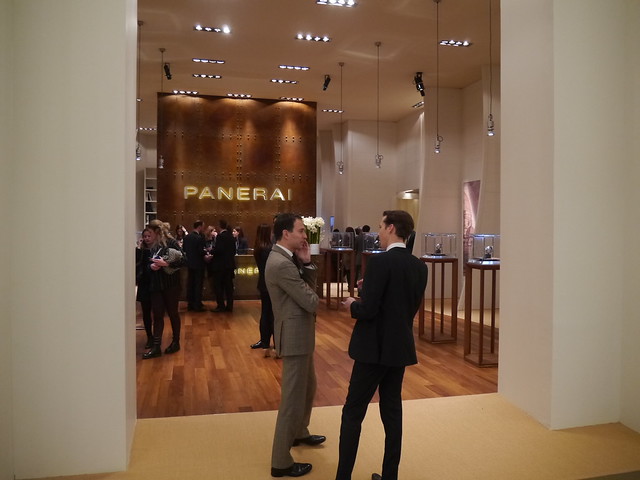
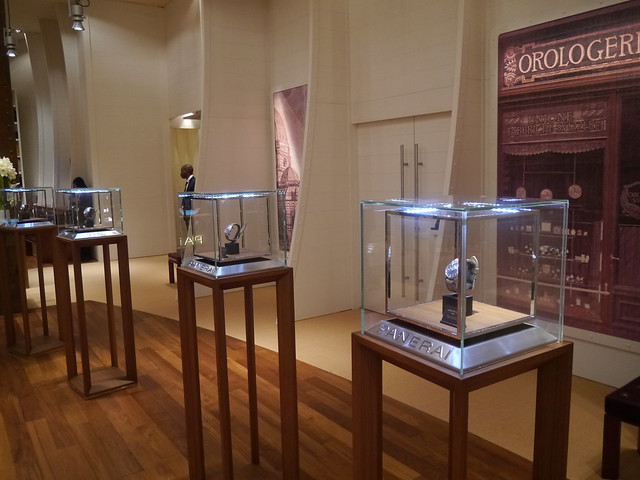
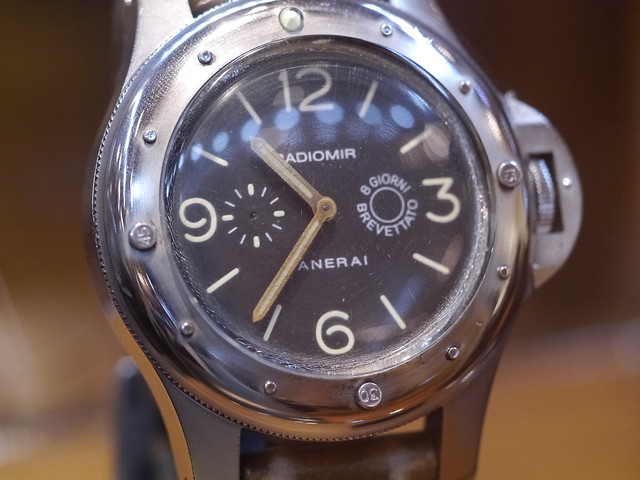
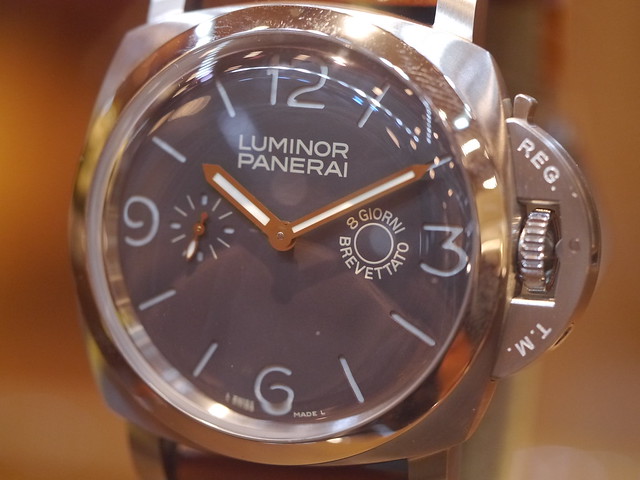
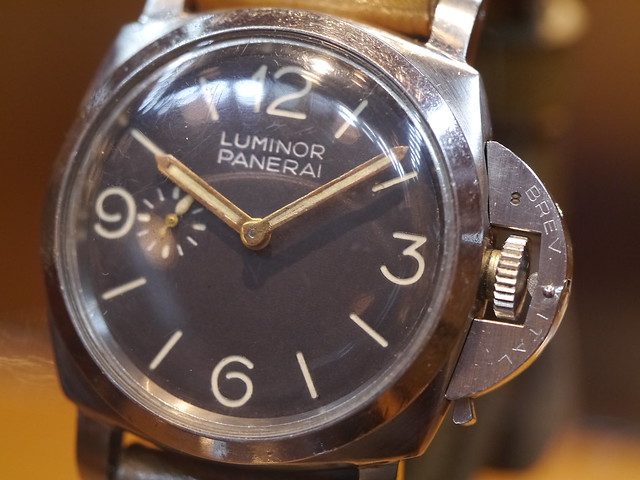
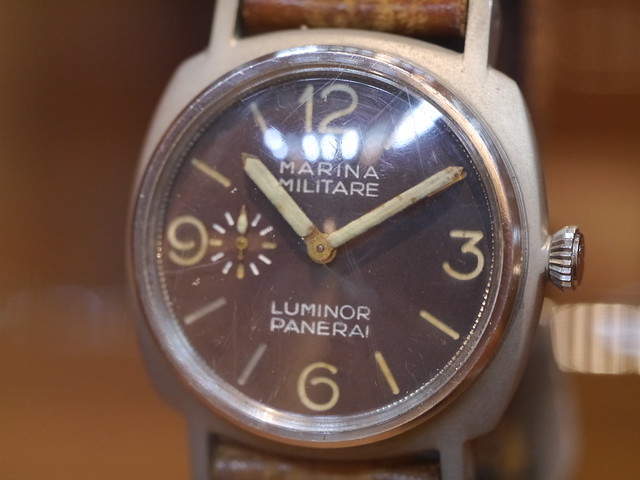
Фотографии новинок. Винтаж сначала, затем усложнения и затем новые радиомиры.
662 и 663 не скажу, что понравились очень. Примечательно, что никто из моих знакомых, владеющих 372/557/587, не заказал 662/663. Обычно эти люди скупают все интересные SE.
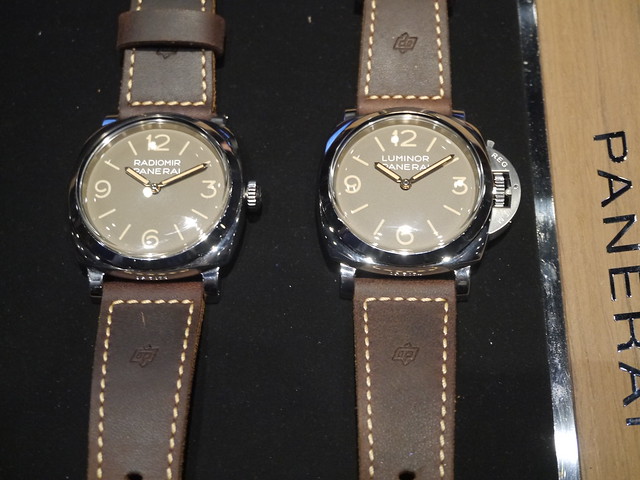
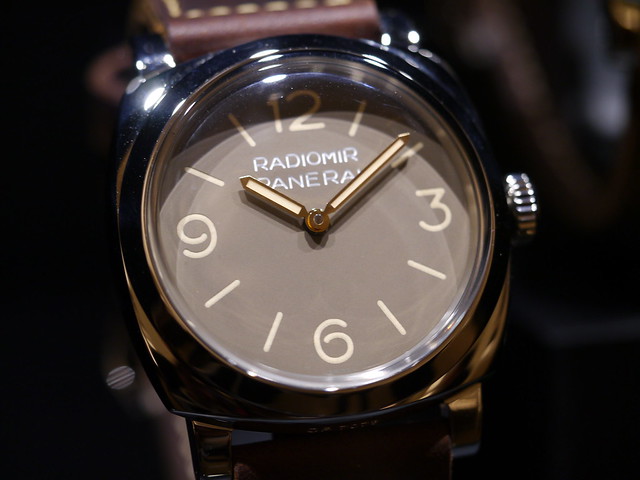
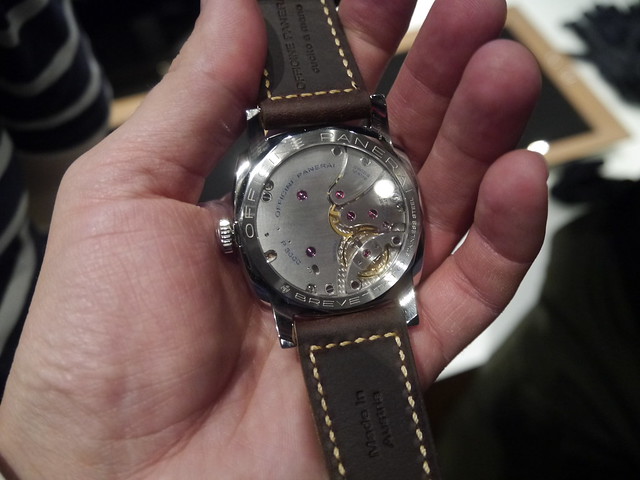
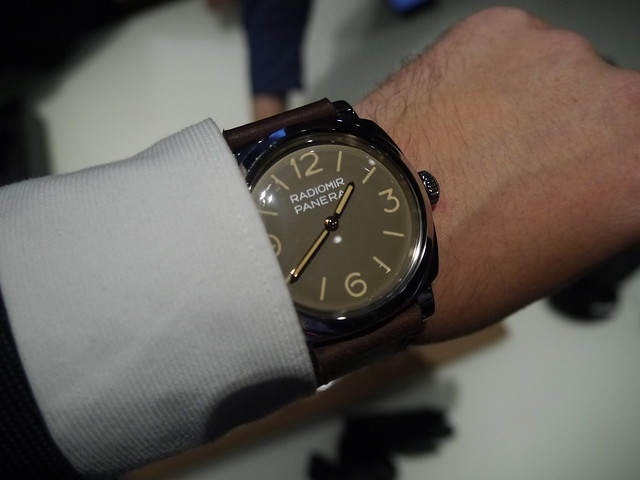
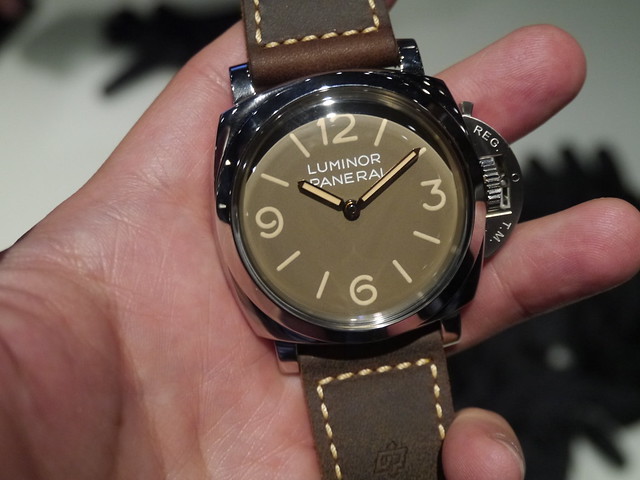
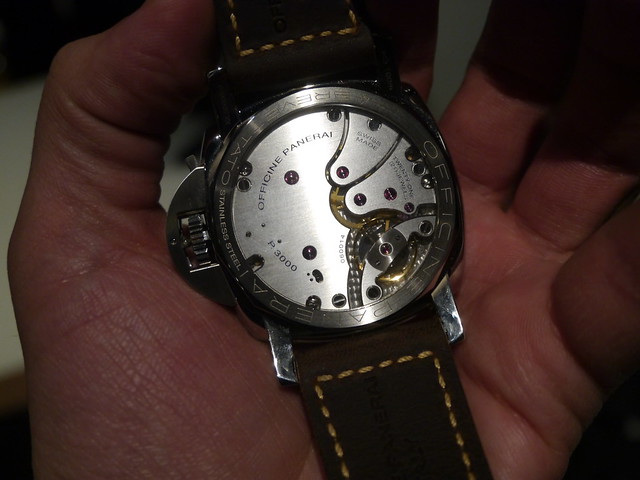
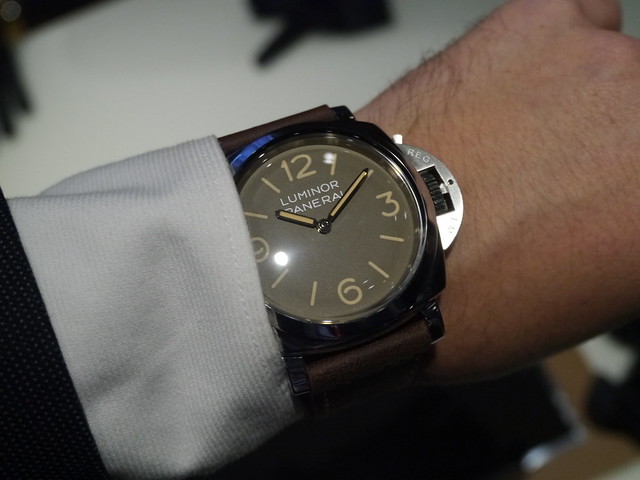
Пресс-релиз. Сорри, на английском.
Цитата:
Those interested in the history of watchmaking are well aware that the names Radiomir and Luminor, which today identify the cases, originally referred to the two luminous materials created to achieve the legendary visibility at night or underwater which have always been a feature of the dials of Panerai watches. It began with the invention of Radiomir: this was a powder based on radium, patented by Guido Panerai in 1916, to make luminous gun sights and other optical devices exceptionably visible in the dark. It was Radiomir which was used on the dial of the firstever Panerai watch in 1936, and for several years this remarkable luminous substance was one of the closelyguarded military secrets which enabled the commandos of the Royal Italian Navy to carry out their extraordinary missions in the depths of the sea at night, equipped with instruments specially created by the Florentine watchmaker.
In the 1940s people were concerned about the radioactivity of radium powder and therefore in 1949 Panerai patented Luminor, a new luminous substance based on tritium, some 20 times less radioactive. The replacement happened gradually, because some of Orologeria Panerai’s clients preferred the unrivalled visibility of Radiomir even after the invention of Luminor, and this explains why some watches were produced using this substance even in the 1950s. At a distance of several decades, it is the colour of the dial which tells this story about Panerai’s exceptional luminosity. The effect of the radium-based powder – and also to a lesser extent that based on tritium – has been to bring about a change in the colour of the dials of some vintage watches, transforming the original black into a characteristic brown, which helps to make each of these models unique and different from all the others. Two new Special Editions, made in 1,000 examples each, draw inspiration from this detail to appeal to lovers of the history of watchmaking: the Radiomir 1940 3 Days (PAM00662) and the Luminor 1950 3 Days (PAM00663).
THE EGIZIANO PICCOLO
Among the clients of Panerai who asked for a Radiomir watch, after the Luminor patent application, was the Egyptian Navy, which for the first time in 1954 turned to the Florentine watchmaker for the supply of a special series of diver’s watches designed for frogmen. It was this request which gave rise to one of the most fascinating watches in the history of Officine Panerai, known to collectors by the reference 6154 and the name “Egiziano Piccolo” – to distinguish it from its famous successor, the Egiziano of 1956 – and today it is presented again as a Special Edition: the new Radiomir 1940 3 Days. Originally no more than 30 or 40 examples of the Egiziano Piccolo were produced, making it one of the most soughtafter vintage Panerai watches, and the new Radiomir 1940 3 Days is a faithful re-creation of it, updated to meet the current standards of high quality sports watchmaking. It uses the Radiomir 1940 case in the historic size of 47 mm in diameter, today made of AISI 316L stainless steel with a polished finish. The lugs are formed from the block of the case itself. The winding crown is cylindrical and the profile of the watch is particularly elegant with the sharp edge of the caseband.
THE BIRTH OF THE DEVICE PROTECTING THE WINDING CROWN
The other Special Edition created by Officine Panerai is the new Luminor 1950 3 Days. In this model, the same brown dial is fitted in a Luminor 1950 case, immediately recognisable by the bridge-shaped device with its locking lever which exercises a light pressure on the winding crown to protect it from accidental shocks and to help ensure the watch’s water-resistance. This device had certainly been invented and used even earlier, perhaps even before the end of the 1940s, but the patent application was only lodged as late as 1955, probably delayed because of the military secrecy imposed by the Italian Navy. The new Luminor 1950 3 Days has the Luminor 1950 case of AISI 316L stainless steel, in its first historic version: the one with a diameter of 47 mm, its cusped shape reminiscent of the cases of the first Radiomir watches.
HISTORIC INSPIRATION COMBINED WITH CONTEMPORARY HIGH QUALITY SPORTS WATCHMAKING
The distinctive, original element of both these new models is the brown dial, its colour inspired by that of the vintage watches which have undergone the discolouring effect caused by the luminous material. The substance used today to achieve exceptional night visibility, typical of all Panerai watches, is Grade A Super-LumiNova®, applied to the incisions made in the dial corresponding to the classic, large markers which indicate the hours. To protect the dial, the crystal is made not of sapphire glass but of lightly cambered Plexiglas®, as in the vintage examples where the crystal was made of polymethylacrylate. The hands too reproduce those of the period Panerai watches and the OP reference is engraved between the lugs, exactly as it was in the historic models. Through the sapphire porthole on the back of the new Special Editions, the hand-wound P.3000 calibre, entirely made in the Panerai Manufacture in Neuchâtel, can be admired. Accurate, durable and reliable as befits a Panerai movement, the P.3000 has two spring barrels which enable it to accumulate a power reserve of three days and it is here presented for the first time with a new appearance. The structure of the movement is now protected by four brush-finished bridges, including the one with twin supports which in a particularly stable manner secures the balance oscillating at a frequency of 3 Hz (21,600 vibrations per hour). The P.3000 calibre also has the useful device which enables the hour hand to be swiftly and accurately adjusted forward or backward, without interfering with the running of the minute hand. Both models are supplied with a Ponte Vecchio strap in brown leather with visible ecru sewing, the heatengraved OP logo and a tongue buckle in polished steel personalised Panerai. The elegant wood box in which the two new Special Editions are supplied also contains a spare Plexiglas® crystal. The watch is water-resistant to 10 bar (equivalent of a depth of about 100 metres).
|
Коробочка неплохая, но ценник немилосердный. В принципе, это тоже было общим местом на выставке, обсуждение ценовой политики Panerai.
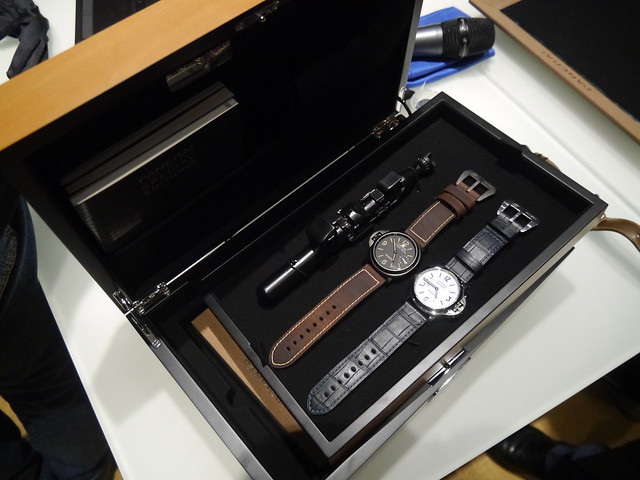
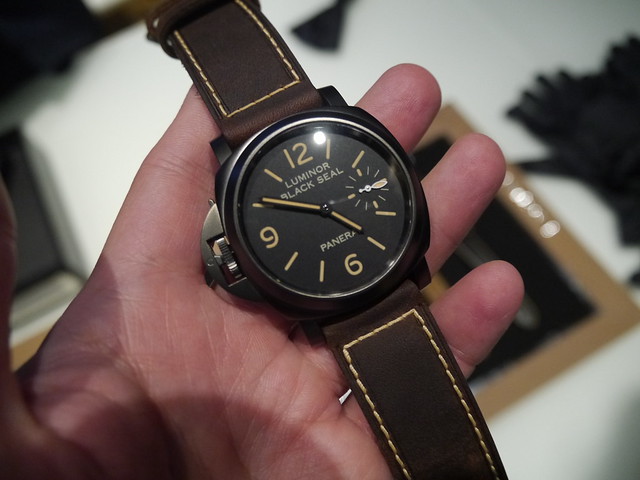
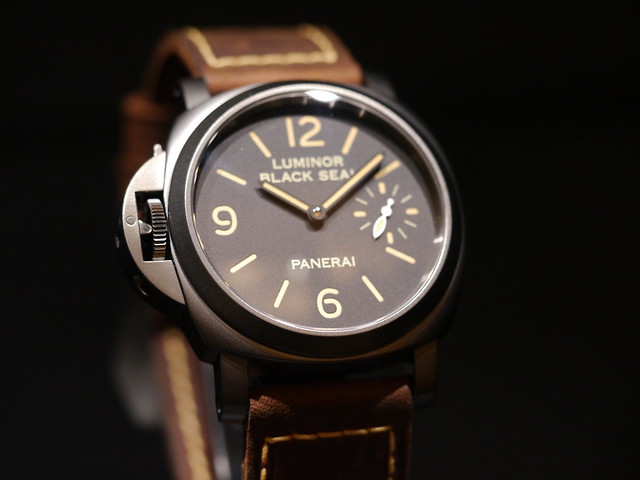
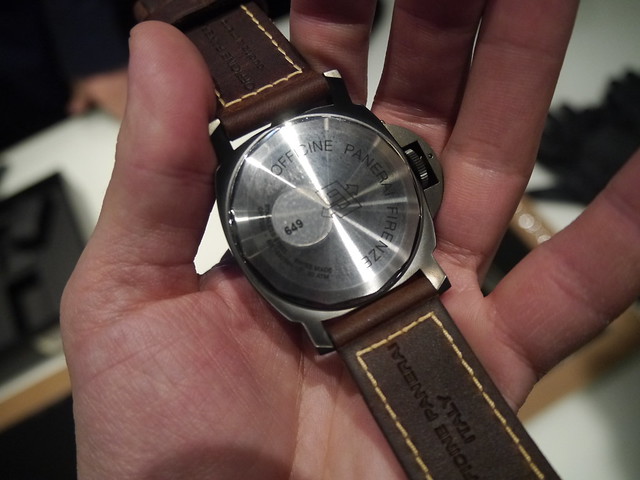
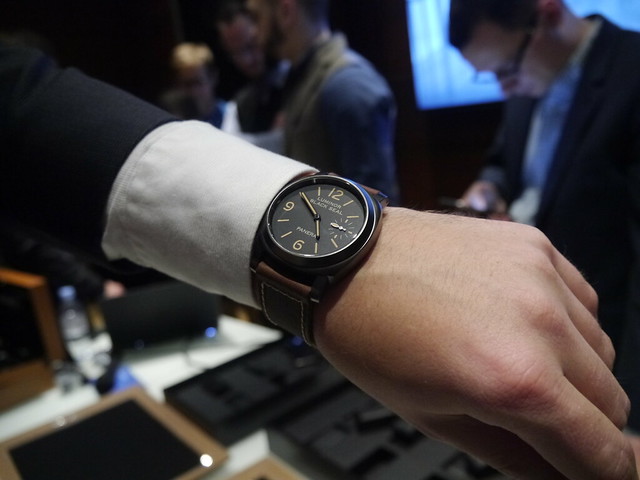
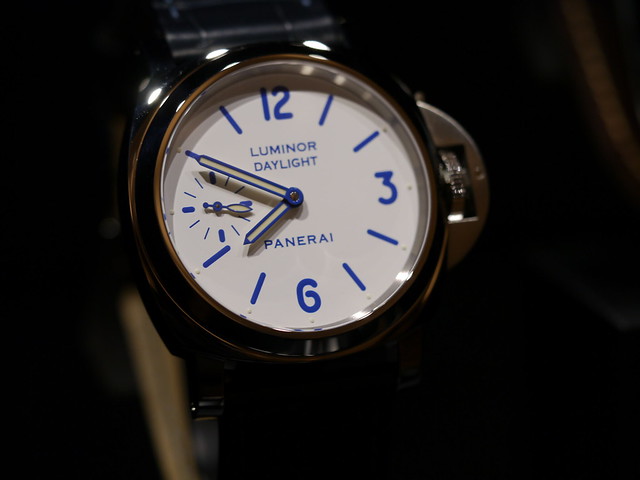

Пресс-релиз для интересующихся:
Цитата:
Officine Panerai continues looking into its own past to relate fascinating new stories to its enthusiastic collectors. A new Luminor 8 Days Set – available in only 500 examples – contains two watches inspired by models created in the pre-Vendôme era, that is, that stage in the history of the brand running from 1993, the year of the first collection made for the public, and 1997, the year in which Panerai was acquired by Vendôme, part of the Richemont Group. In those years, a very small number of watch was produced and they quickly became highly sought after in the collector’s market.
Notably, in 1996 Panerai made a few small series of watches commissioned by Sylvester Stallone. The new Luminor 8 Days Set takes two models originally created for the American actor: a Luminor Black Seal, here presented for the first time in a left-handed version, and a Luminor Daylight with an original, extremely rare white dial with blue markers and numerals. The two watches are supplied in a box inspired by those used for vintage Luminor watches, made of pear wood with a teak base and containing a model of the human torpedo (Siluro a Lenta Corsa – slow speed torpedo), together with a rare publication about the military equipment of the special forces of the Royal Italian Navy, in which Panerai watches and instruments appear. The Luminor Black Seal Left-Handed 8 Days is the version with the winding crown and the lever device protecting it on the left side of the case of the historic Luminor Black Seal. The tradition of making watches for left-handers had already been started by Panerai in the 1940s, when some models were made in this way to enable the watches to be worn on a frogman’s right wrist, while the compass and depth gauge were worn on the left. The Luminor Case, 44 mm in diameter, is made of stainless steel coated with DLC (Diamond-Like Carbon), The Luminor Daylight 8 Days, the other watch in the Luminor 8 Days Set, is the reproduction of a model of 1996 of which only a very few examples exist. The striking detail of the historic example, faithfully reproduced in the new model, is the white dial – as in the Daylight models of the time – on which, unusually, all the markers and the hands are an intense blue colour. It is likely that this version was replaced after the delivery of the first prototypes, so the few surviving examples have become extremely rare. The hands, including the small seconds hand at 9 o’clock, are blue, as are the large markers indicating the hours. In this model the case 44 mm in diameter is made of AISI 316L stainless steel with a polished finish, as is the winderprotecting device placed traditionally on the right side. In keeping with the dial the strap is blue alligator, and the steel tongue buckle is sewn-in, as in the vintage models. The Luminor case of both watches of the Luminor 8 Days Set (PAM00786) is closed by a screw back, engraved with the words “Officine Panerai Firenze” and the OP logo, and each of them has a hand-wound movement with a power reserve of at least eight days, stored in two spring barrels connected in series. The P.5000 calibre, entirely made in the Panerai Manufacture in Neuchâtel, recalls many of the “historic” characteristics of the calibres used in the watches at the time – such as the hand winding and the long power reserve – but it meets the standards of contemporary high quality watchmaking in the purest Panerai style, the structure of the movement being remarkably strong with its large bridges protecting the mechanism and the balance bridge with twin supports.
Both watches are water-resistant to 30 bar (equivalent to a depth of about 300 metres) and the special box in which they are supplied also includes a spare strap for each model and a screwdriver.
|
Lo Scienziato – Luminor 1950 Tourbillon GMT в титане. Очень легкие часы. К сожалению, опять же наш офис русскоязычного пресс-релиза не подготовил, размещу англоязычный, надеюсь будет интересно.
Цитата:
The Laboratorio di Idee of the Manufacture in Neuchâtel is continually searching for new, remarkable solutions to make Panerai watches even more impressive technically, without losing their unmistakable identity. One of the most prestigious results of this research and development is the “Lo Scienziato” skeletonised tourbillon collection, dedicated to the Tuscan genius Galileo Galilei, who with his discoveries laid the foundations for the development of mechanical timepieces. The most recent model of this distinguished series is the new Lo Scienziato – Luminor 1950 Tourbillon GMT Titanio, a Special Edition limited to
only 150 examples.
A REMARKABLE LIGHTNESS
The lightness of the new Lo Scienziato is truly remarkable, particularly considering its size and its wealth of features: hours, minutes, small seconds, GMT with am/pm indication, a power reserve of six days with indication of the power remaining on the back, and a tourbillon escapement. The secret of its lightness lies in the ingenious work of minimalisation carried out by the Laboratorio di Idee of the Panerai Manufacture in Neuchâtel on the case and on the sophisticated P.2005/T movement, to design a watch with the typical Panerai characteristics but with a substantially lower weight.
The Luminor 1950 case of the new Special Edition has the classic diameter of 47 mm and it is made of titanium, a material that is not only hypoallergenic and resistant to corrosion but also about 40% lighter than steel. To reduce the weight further, the case is made using an innovative technology which enables it to be hollowed out internally, forming an extremely complex geometrical cavity without in any way compromising its water-resistance (10 bar, equivalent to a depth of about 100 metres), its solidity or its resistance to any tension or torsion to which the case may be subjected. The technology used is called Direct Metal Laser Sintering: this process builds up a 3D object layer by layer by means of a fibre optic laser using powdered titanium. The successive layers – each one only 0.02 mm thick – merge together and become completely solid, creating forms which would be impossible to achieve using traditional working methods, lower in weight and with a perfectly uniform, even appearance.
THE P.2005/T CALIBRE
The P.2005 mechanical movement, the hand-wound calibre with the special tourbillon patented by Panerai, appears here for the first time in the P.2005/T version, skeletonised and with titanium bridges and plates. Thanks to the lower density of this material – about half that of the brass of which these components are normally made – the overall weight of the movement is 35% less than that of the P.2005/S skeletonised version. The ultimate lightness of the watch is both the result of the fine skeletonising of the bridges, plates and spring barrels, and of the absence of a traditional dial, since all the elements which normally comprise it are attached directly to the movement or the flange of the watch, such as the hour markers. At 9 o’clock is the small seconds dial, inside which a small indicator rotates, showing the rotation of the tourbillon. At 3 o’clock, another small dial indicates whether the central second time zone hand (GMT) refers to day or night. The long power reserve of six days is achieved by the three spring barrels connected in series, and the power remaining is shown by a special indicator on the back of the movement, visible through the large sapphire crystal porthole on the back of the watch. All this fine work of skeletonising enables the fascinating details on both sides of the watch to be admired, such as the winding and unwinding of the spring inside each barrel, the intricate interconnection of the wheel work and in particular the rotation of the tourbillon cage, which, in the version patented by Panerai, is fundamentally different from the normal arrangement. In order to compensate more precisely for the effects of gravity on the escapement, thus achieving more accurate operation, the tourbillon cage rotates on an axis which is perpendicular, not parallel, to that of the balance, and it makes a complete rotation every 30 seconds instead of once a minute.
|
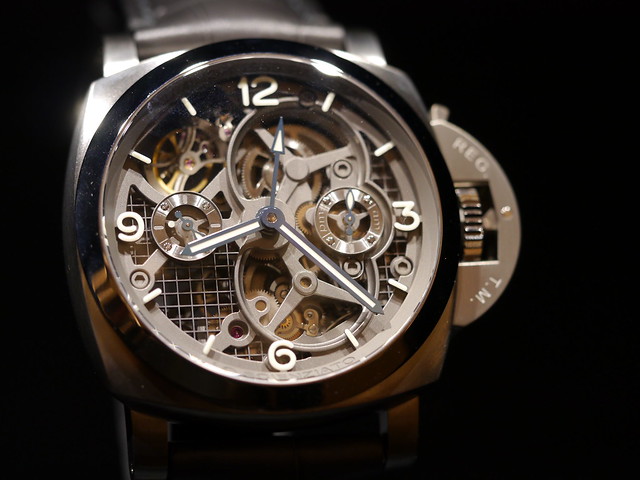
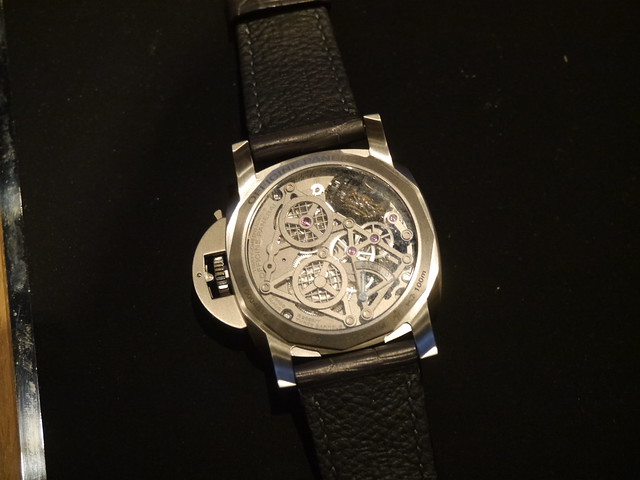
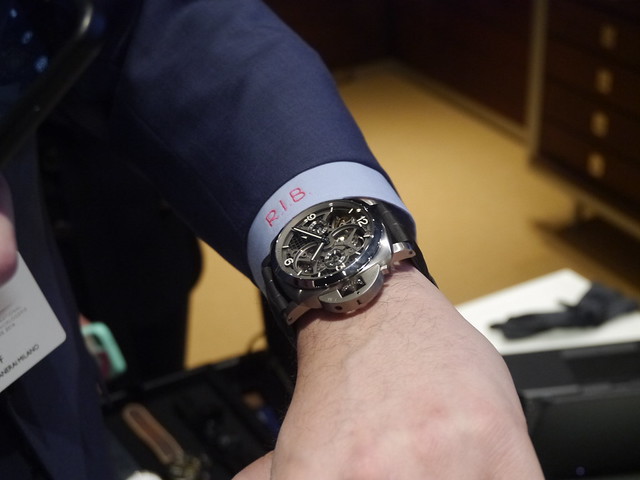
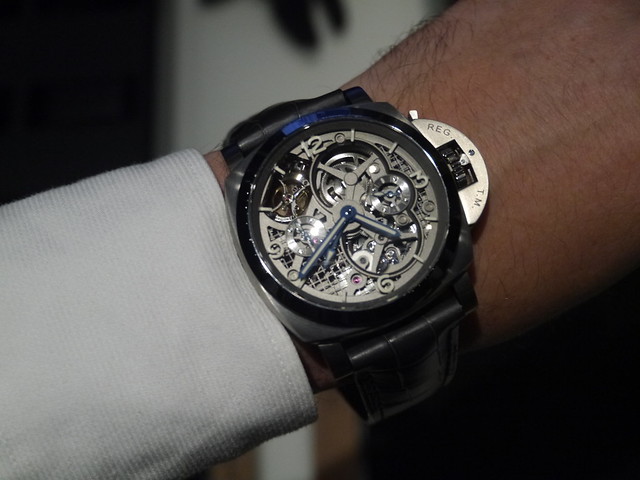
И Радиомир 1940.
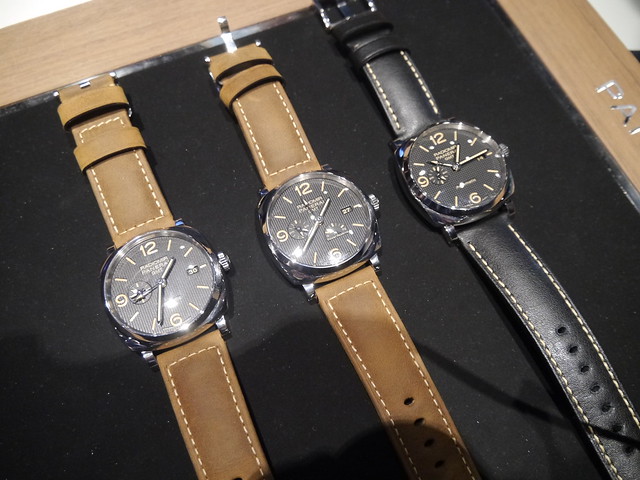


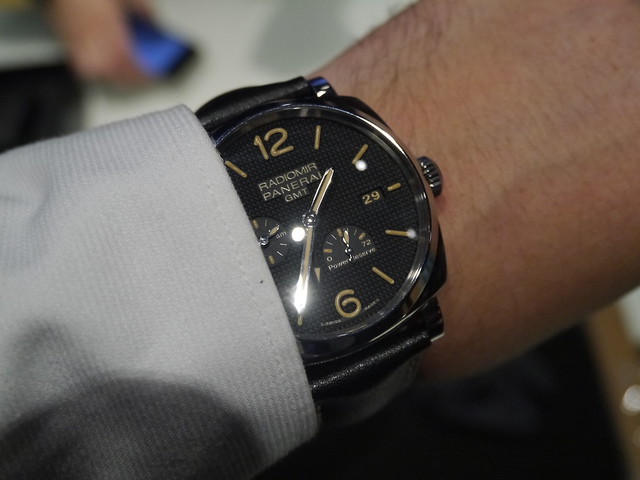
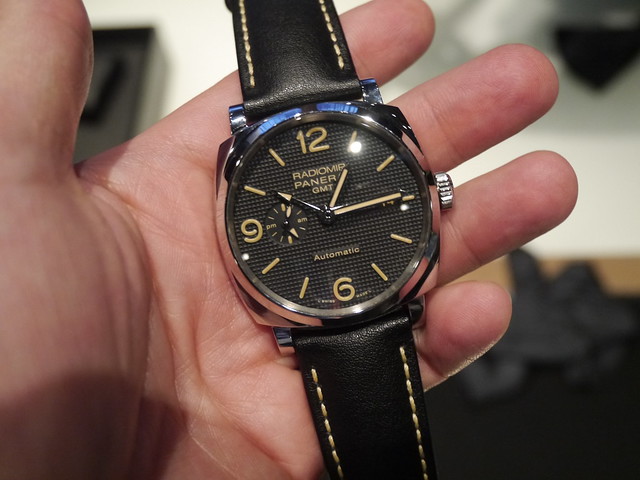
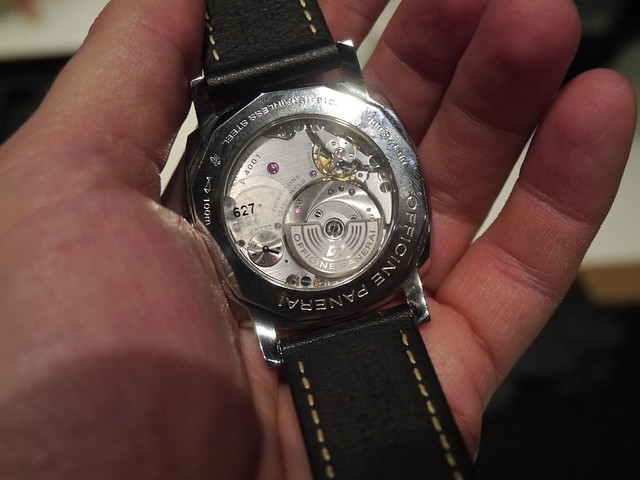
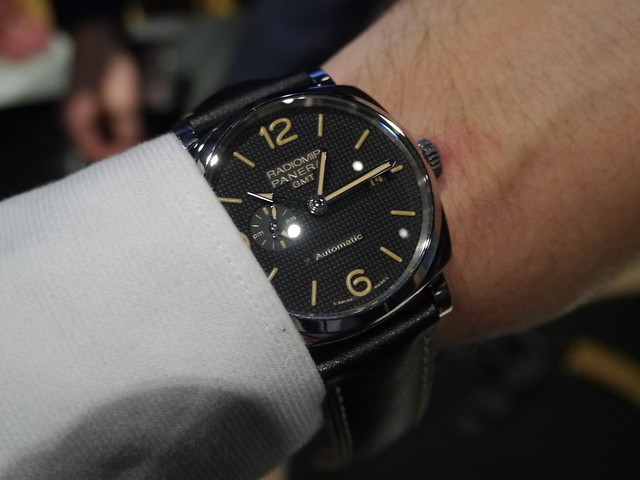
Ну и размещу заготовки корпусов и циферблатов, которые на витринах валялись в качестве аксессуаров.
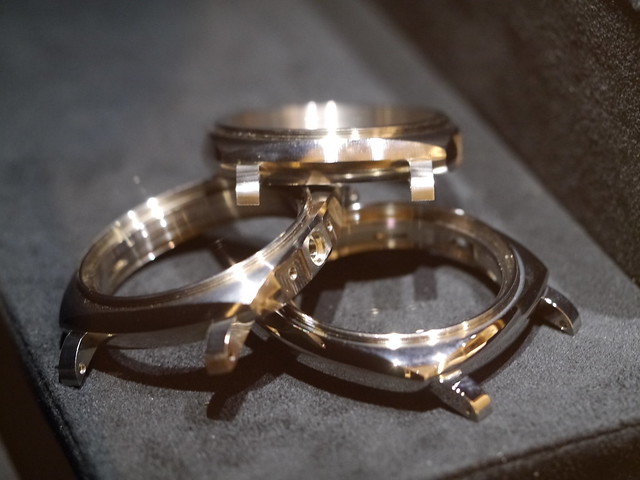
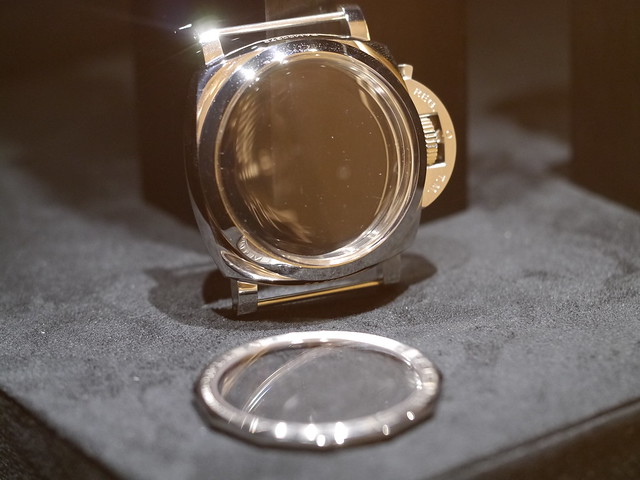
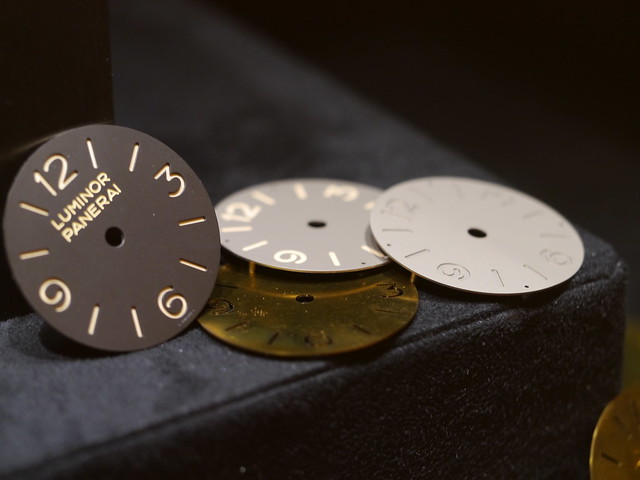
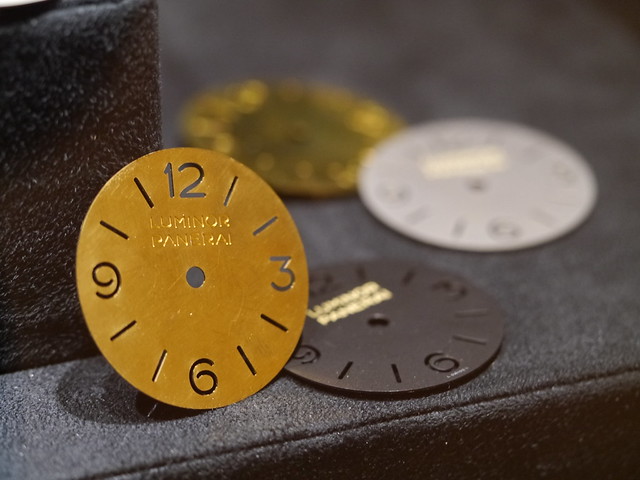
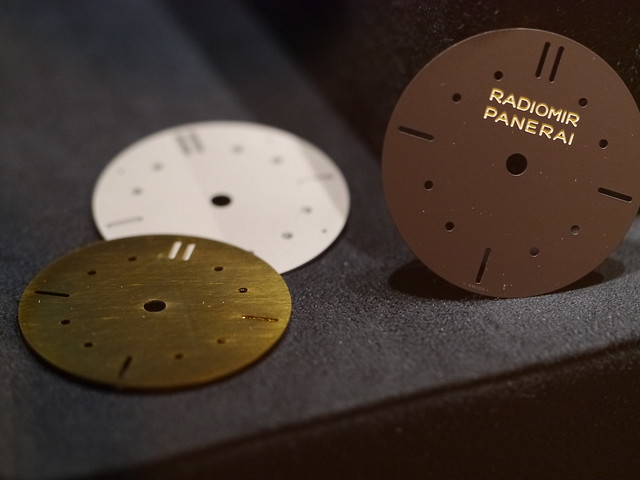

|














 Похожие темы
Похожие темы